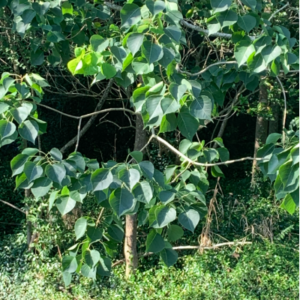Hydrothermal Processing of
Chinese Tallow Tree

Introduction
Biomass, including degraded and partially-transformed wastes, has residual energy that can be recovered and used for human needs. Biomass transformation into a chemical feedstock, product, or mixture requires that some energy be invested into the system to 1) render the physical characteristics of the material amenable to the operating parameters of the treatment, and 2) to perform chemical reactions that provide desired end products (Catallo and Shupe 2003; Catallo et al. 2004).
In the many approaches to biomass conversion, these can include mechanical processing, heat, catalysts, and/or special chemicals (solvents, reactants), which can be expensive, toxic, or otherwise hazardous. Hydrothermal (HT) refers to near- and supercritical water systems (e.g., 350°–450°C, 200–500 bar) under anoxic and reducing conditions.
HT conditions are achievable in many settings, including field deployable units, modest in terms of energy required, and require abundant and recyclable materials/reactants (i.e., water and inorganic salts). HT treatments of all types of biomass (i.e., protein, cellulose, chitin, starch, DNA, bacteria cells, yeast cells, diatom cells, decommissioned preservative-treated wood wastes, grass (Spartina alterniflora), pond weeds (Lemna sp.), and municipal sewage slurry) have resulted in transformation of the bio-molecules to mixtures of gas and liquid phase aromatic and aliphatic chemicals (Catallo and Junk 2001; Catallo and Shupe 2003; Catallo et al. 2004). Previous research on HT treatment of decommissioned waste wood containing residual preservatives showed that (1) wood biomass can be transformed into useful hydrocarbon mixtures, and (2) HT conditions can be achieved that allow for recovery or destruction of residual preservative chemicals (Catallo and Shupe 2003; Catallo et al. 2004).
Chinese tallow tree
Woody crops hold great potential for biomass production (Hansen 1992). Short rotation woody crops are mainly used as a fiber source for the pulp and paper industry. Fast-growing woody crops are also beneficial because they lessen the harvest demand on public and private forests. This is particularly important in the U.S. South because federal regulation and forest land ownership have caused a shift in fiber production from the Pacific Northwest to the South. The primary factor contributing to this shift is concern over endangered species and other possible adverse environmental impacts. (USDA FS 1997). There is a huge global demand for wood fiber. The U.S. domestic consumption of wood fiber is equivalent to the consumption of a 6-ft. (1.8-m) long 2- × 4-in. (5- × 10-cm) piece of lumber per person per day. Globally, this consumption is equivalent to 2-ft. (0.6-m) of a 2- × 4-in. (5- ×10-m) piece of lumber per person per day (McLain 2001). Coincident with the increased demand for wood products, a major change has occurred in the species composition of the forests of the southeastern U.S. In particular, Chinese tallow tree (Triadica sebifera [syn. Sapium sebiferum]) is widespread and noxious (USDA NRCS 2004). The species is extremely well adapted to numerous environments (Conner 1994; Donovan et al. 1988; Jones and McLeod 1989; 1990), and there are no known diseases that debilitate it (Scheld et al. 1980). Also, it produces above-ground biomass at a significantly faster rate than most other tree species (Harcombe et al. 1993; Rockwood et al. 1993) and is able to establish a dense stand quickly.
As a result of its inherent chemical properties and its proliferation in the landscape, tallow tree is an excellent candidate for biomass conversion using HT treatment. The objective of this research was to examine the potential of Chinese tallow trees for HT chemical conversion. The goals included (1) product chemical analysis and comparison of HT-treated ground leaves, bark, and whole seeds; (2) identification of structural and ultra structural features of HT-treated versus untreated whole seeds (effect of substrate surface area size on products); and (3) an evaluation of the energy value btu/lb (J/kg) of untreated seeds as compared to the seeds following HT treatment.
Findings
This work explored the potential of Chinese tallow tree (wood/bark, leaves, and seeds) as a raw material for bio-based chemical and energy production using hydrothermal (HT) conversion. Seeds were HT-treated in the whole and ground states. Ground wood/bark, leaves, and seeds yielded similar aromatic compound assemblages after HT treatment. Ground seeds yielded unique minor by-products and did not contain naphthalene, which was present in the other tissue types. Whole HT-treated seeds yielded a material that resembled asphalt in appearance, odor, and chemical properties but did not produce any phenol. In contrast, ground seeds did not yield any particulate matter and had substantial amounts of phenol. In terms of elemental analysis of the ground and whole seed HT samples, the residues had increased C:H weight ratios. With regards to the energy input/output of this work, the HT treatment had a fairly neutral effect on energy content of the tallow seeds. The energy values of the tallow seeds are much higher than those typically reported for hardwood stemwood.
Condensed from: Todd Shupe, T.F. and W.J. Catallo. 2006. Wood Fiber Sci. 38(1)55-63.
To read more click HERE .
Meet the Author
Dr. Todd Shupe is the President of Wood Science Consulting, LLC. He is a well-recognized expert on wood forensics, wood preservation, wood decay and degradation, and wood species identification. He has a broad background in new product development, quality management, and marketing and sales in both the public and private sectors. For more information please visit DrToddShupe.com.
We welcome your comments below.
Thank you for visiting. We trust that you have enjoyed reading our articles.
Liked this post? Read more below or search for more topics . . .

